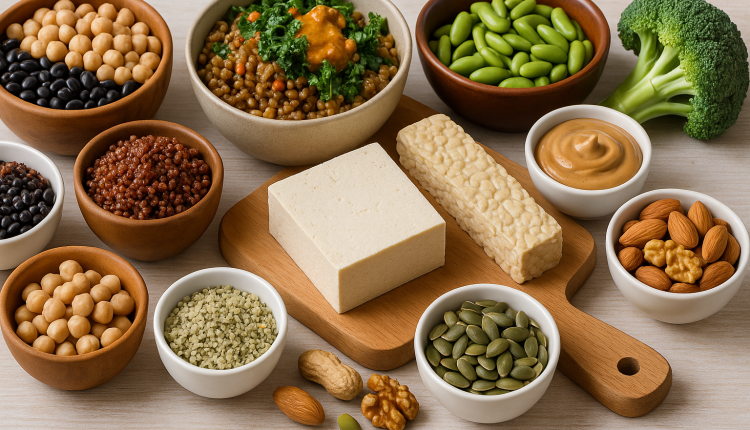In recent years, plant-based eating has risen from a fringe trend to a lifestyle embraced by millions. Whether you’re choosing this route for health, sustainability, or animal welfare, getting enough protein can be a central concern. Many people worry they won’t meet their daily protein needs without meat or dairy—but with thoughtful planning, it’s easier than you think. In this article, we’ll explore why plant-based protein matters, how much you really need, and practical ways to incorporate it into your daily meals—without spending hours in the kitchen or resorting to supplements.
Why Focus on Protein?
Protein is essential for repairing tissues, building muscle, supporting hormones, and maintaining a healthy immune system. If you’re working out, recovering from illness, or getting older, your protein needs may be higher. Also, protein helps with satiety—eating protein at each meal can reduce cravings and support weight management.
Official dietary guidelines suggest 0.8 grams of protein per kilogram of body weight daily for average adults. For someone weighing 70 kg (154 lb), that’s about 56 grams. Active individuals or older adults often benefit from 1.2–1.6 g/kg, depending on physical activity and health status.
Plant Protein Basics: Quality and Quantity
Unlike animal sources, most plant proteins lack one or more essential amino acids. However, by combining different sources throughout the day, you can easily achieve a complete amino acid profile.
| Plant Source | Protein / 100 g (cooked) | Notes |
|---|---|---|
| Lentils | 9 g | High in fiber, lutein, folate |
| Chickpeas | 8.9 g | Great for salads, stews, hummus |
| Black beans | 8.9 g | Antioxidants, satisfying texture |
| Quinoa | 4.4 g | Pseudograin, complete protein |
| Tofu (firm) | 8 g | Versatile texture, absorbs flavors |
| Tempeh | 19 g | Fermented soy, nutty taste |
| Edamame | 11 g | Snackable, steamed or in stir-fries |
| Nuts & seeds | 15–30% by weight | Good fats and protein (e.g. almonds, pumpkin seeds) |
Easy Tips to Add Protein Throughout the Day
- Start with a Power-Packed Breakfast
- Oatmeal with chia seeds, hemp seeds, and almond butter
- Smoothie made with soy milk, frozen berries, spinach, and pea protein powder
- Savory tofu scramble or chickpea flour pancake
- Snacks That Sustained You
- Roasted chickpeas with paprika and garlic powder
- Edamame pods dusted with sea salt
- Trail mix made of nuts, seeds, and dried fruit
- Protein-Rich Lunches & Dinners
- Buddha bowl: quinoa base + roasted vegetables + 100 g tempeh + tahini drizzle
- Lentil curry served over brown rice or whole-wheat roti
- Black bean tacos with salsa, avocado, and cabbage slaw wrapped in corn tortillas
- Boost Every Recipe
- Stir chia or flax into yogurt, pudding, soups, or smoothies
- Mix hemp hearts into salads, granola, or mashed potatoes
- Puree white beans into pasta sauces to add creaminess and protein
Meal Planning: Sample Day for ~75 g of Protein
| Meal | Ingredients & Portions | Approx. Protein |
|---|---|---|
| Breakfast | Overnight oats + 2 Tbsp chia + 3 Tbsp hemp + 2 Tbsp peanut butter | 20 g |
| Snack | ¾ cup edamame + apple slices + 1 Tbsp almond butter | 17 g |
| Lunch | Lentil & quinoa salad with veggies, olive oil & lemon | 18 g |
| Snack | ¼ cup mixed nuts & seeds + 1/2 cup Greek-style soy yogurt | 12 g |
| Dinner | Stir-fry: 150 g tofu + broccoli + peppers + tamari + whole-grain noodles | 25 g |
| Total | ≈92 g |
That leaves leeway for occasional dips or desserts like fortified soy milk hot cocoa or protein brownies.
Overcoming Common Hurdles
- “I don’t know how to cook legumes.”
Pre-soak beans overnight to reduce cooking time. Toss in a bay leaf to soften skins. Pressure cook for a quick, tender result. - “It’s too bland/fruity to always eat salads.”
Experiment with spices: cumin, smoked paprika, turmeric, curry, za’atar, everything bagel seasoning. Use citrus juice, vinegar, or fermented condiments for punch. - “Where do I get enough protein without eating so much?”
Use denser sources like tempeh, tofu, seitan (if gluten is okay), legumes, and pulses. Add nuts and seeds liberally. - “Do I need supplements?”
With diverse whole foods, vitamin B12 is the main concern. Consider a daily B12 supplement (e.g., 250–500 µg cyanocobalamin). If sunlight is limited, check vitamin D, especially in higher latitudes.
Bonus: Smart Swaps & Hacks
- Swap ground beef in chili for crumbled tempeh or textured vegetable protein (TVP).
- Stir beans into jars of marinara before heating—instantly ups protein and fiber without altering texture.
- Choose fortified plant milks (soy, pea, oat) to boost nutrients.
- Keep a jar of miso in the fridge for protein-rich soup starters or veg gyōza dips.
- Make a large batch of chickpea salad (like egg salad) for easy sandwiches all week.
In Summary
Shifting to a plant-based diet doesn’t mean compromising on protein—far from it. By mixing legumes, whole grains, soy products, nuts, and seeds and using simple swaps, getting 70–100 g of daily protein is entirely feasible. Across just a few meals and snacks, you can hit your nutrition targets, support your health goals, and enjoy a varied, flavorful plate. Embrace the endless seasonings, international cuisines, and hearty combinations that make plant-powered eating vibrant—and protein-rich—for every day.


